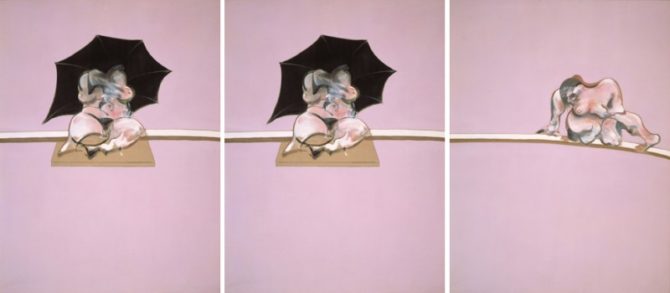The Rare and the Beautiful

Art and antiques shows crowd the international calendar, but the Biennale des Antiquaires in Paris stands apart, as elegant as the city itself. This year the Biennale celebrates its 25th anniversary with an exceptional edition: 80 international galleries, dealers and jewelers presenting their rarest and most beautiful wares in sumptuously decorated stands under the soaring Belle Epoque glass roof of the Grand Palais.
The expected 80,000 collectors, museum curators, decorators and their haute clientele who flock to the Biennale are as glamorous as the wares on display. As described by Pierre Levai, president of New York’s Marlborough Gallery, which is making its debut at the fair this year with such major works as a Francis Bacon triptych and Andy Warhol’s monumental Double Hamburger, the Biennale crowd is alluringly “distinct” from the attendees of other such events.
What le tout international will find this year: a simplified floor plan with a verdant decor of rose arbors leading into a grand square around an ornamental pool. Off the square, single alleys left and right lead to the stands, replacing the confusing labyrinth of previous years. By night, fountains and illuminations will add more glitter to the sophisticated spectacle.
Among other innovations, the directorate of the Syndicat National des Antiquaires, which organized the fair under new SNA president Hervé Aaron, has created a special Tremplin (springboard) section, to showcase 25 young dealers invited to display one exceptional object each. And in a new spirit of inclusion, there is now a recognized Biennale Off, a rich offering of Parisian gallery and museum exhibitions outside of the fair that include many former Biennale participants.
Showstopper surprises
But the magnet remains the Biennale itself, where visitors will discover the stupendous selection of museum-quality works for which it is renowned. Archaeology, Asian arts, antique arms, rare books and coins, Old Master paintings and drawings, antique furniture and objets d’art from the 17th to the 20th centuries, striking sculpture, priceless porcelain and eye-popping jewels—many dealers hoard their best wares for months in order to spring knock-’em-dead surprises on the public and their peers, and every item must pass a draconian vetting for quality and authenticity before taking its place in the lavishly embellished stands.
The first surprise registers at Booth 1, where Parisian antiquaire Kraemer & Cie, founded in 1875, is presenting some 30 extraordinary 18th-century French antiques in a decor that recreates “the best known room in the world, the Oval Office of the White House,” says Laurent Kraemer—an imaginary Oval Office as it might be furnished by Kraemer. Instead of power politicos, the room will boast such power pieces as a sculpted and gilded wood table, c.1720, depicting four continents—Europe, America, Asia and Africa—and a ravishing star-spangled, blue-lacquered sphere chandelier, c. 1800, similar to one in the Getty collection. With this “Franco-American cultural wink,” Kraemer hopes to attract the elite American clientele that distinguishes the Biennale.
In a turnabout, American ceramics dealer Jason Jacques is making his Biennale debut with a showstopper French setting by eminent Parisian decorator François-Joseph Graf, reproducing the Art Nouveau decor of the 1900 World’s Fair stand of Georges Hoentschel, a Parisian decorator, collector and ceramist.
18th vs. 20th
The Biennale has always excelled in the decorative arts. In recent years the preeminence of FFF—Fine French Furniture of the 17th through early 19th centuries—has been challenged by 20th-century Art Deco and design furniture. But the 18th century is fighting back—witness the success of French galleries Perrin and Didier Aaron at last June’s Design Miami/Basel fair.
FFF highlights at the Biennale include François Léage’s rare set of seven Louis XVI mahogany chairs with saber legs by Georges Jacob, a style shared by Marie Antoinette and Empress Josephine. Perrin Antiquaires is showing an unusual pair of c. 1760 German seashell-art collages depicting seated dogs with garden backgrounds, composed of shells, mother of pearl, coral, quartz and iridescent plaster. Didier Aaron & Cie is featuring a graceful 1730 lacquered beechwood sofa after drawings by German cabinetmaker Johann Michael Hoppenhaupt II. Steinitz, whose stands always enchant, spotlights an opulent Louis XV commode by Jacques Dubois.
The 20th century shot to Biennale stardom in 2000, propelled by the sensational 1930s stand put together by François-Joseph Graf for Galerie Vallois. “The tension is enormous,” sighs Art Deco expert Cheska Vallois, speaking of the quest to match her own super standard. But in fact she’s done it again, with a private collection of about 35 lacquered works by Art Deco master Jean Dunand, never before exhibited or seen at auction. Yves Gastou has his own coup: an amazing 1974 Surrealist cage-bed and screen by artist Max Ernst. Other Deco and modernist treasures will be shown by several Biennale newcomers—Galerie Marcilhac, Alain Marcelpoil, Dansk Mobel Kunst and Michel Giraud—while classic design names like Jean Prouvé, Charlotte Perriand and Alexandre Noll will be found at Downtown and Jousse Entreprise.
Spanning the centuries
Among the top dealers in Oriental art, Paris’s Christian Deydier is bringing an 11th-century bronze Angkor-Wat-school Buddha seated on the coiled serpent king Naga Muchalinda; and Jacques Barrère will show an impressive Greco-Buddhist terracotta head of Vajrapani. Along with Gisèle Croës of Brussels, Deydier and Barrère are behind the fair’s strength in Oriental art, boosted this year by New York Chinese art specialist J.J. Lally, making his first appearance at any art fair. When an American connoisseur offered to sell his collection of Tang Dynasty (618–906 AD) pottery tomb figures of court ladies and attendants, “the challenge was to find a new audience,” says James Lally. “To me, the Paris Biennale is the premier fair, with the finest works of art, the most beautiful display and the most sophisticated clientele—my first choice.”
Crowning a sterling choice of Old Masters: The Ill-Matched Lovers by Lucas Cranach the Elder and his studio, from London’s Bernheimer-Colnaghi; two delightful scenes of wedding festivities by Pieter Breughel the Younger at the Parisian Galerie de Jonckheere; and at Richard Green of London, Salomon Van Ruysdael’s superb 1650 view of an estuary and the town of Weesp, recently described by International Herald Tribune art and auction expert Souren Melikian as “perhaps the greatest river landscape ever done by the Dutch master”.
In painting too, the move is to 20th-century works. L&M Arts of New York and Los Angeles has Willem de Kooning’s Two Women (Study for a Clamdigger) and a luminous untitled 1964 oil by American abstract expressionist Joan Mitchell. Parisian dealers’ starry spectrum includes Nicolas de Staël’s exceptional 1953 White and Yellow Flowers at Applicat-Prazan; a peak-period 1958 Pierre Soulages abstract at Pascal Lansberg; Mary Cassat’s 1909 portrait of a pensive young woman, along with a Bonnard and a Chagall at Galerie Schmit; and an Italian ensemble—Lucio Fontana, Giacomo Balla, Marino Marini and Giorgio de Chirico—along with the Swiss Alberto Giacometti’s 1956 bronze Standing Woman at the Florentine Tornabuoni Art.
Paris coin specialist Sabine Bourgey’s treasure chest stars a rare 1805 Napoleon gold medal with the emperor’s profile. And in a comeback this year, Belgian dealer Axel Vervoordt sums up the Biennale’s eclectic approach with a stand brilliantly melding ancient statuary with contemporary art.
Springing up
The 25 young galleries in the Tremplin section faithfully reflect that eclecticism too. Each Tremplin exhibitor was allowed only one object, so exceptional works abound. Among them: Eric Pouillot’s 8th-century Tang Dynasty terracotta figure of a Fat Lady with a Mirror; Emmanuelle Hadjer’s 18th-century Beauvais tapestry La Collation du Prince (The Prince’s Meal); David Ghezelbash’s 3rd/2nd-century BC marble head of Zeus; and Henri-François Riesener’s Portrait of a Russian Princess from Galerie Alexis Bordes. Three 20th-century offerings here: a pair of curvy c.1924 armchairs by couturier Paul Poiret at Galerie Mathivet; a 1972 edition of Pierre Paulin’s Elysées armchair, originally designed for President Georges Pompidou, at Galerie de Casson; and Jean Cocteau’s 1952 painting Le Vase Etrusque at Dominique Bert.
Best bijoux
Jewelry is becoming increasingly important. Among the remarkable antique pieces, Belgian dealer Véronique Bamps has a c.1890 orchid brooch by Paulding Farnham for Tiffany, and a diamond and emerald brooch at Martin du Daffoy pictures a jockey astride his mount. Geneva’s Faerber clicks into the current Vanités revival with a 1700 coral skull with diamond eyes.
In addition to antique jewelry, the gorgeous gems of Paris haute joaillerie are on show in a special section on the fair’s central square, some in new collections designed especially for the Biennale. At Cartier, there are jeweled flamingos and birds of paradise, while peacock hues dazzle in a massive emerald-and-opal bead necklace with dangling diamonds, a blue cabochon sapphire and a splendid 35.5-carat opal.
The greenery of Versailles inspired Harry Winston’s Royal Gardens array, including a sapphire and diamond tulip cocktail ring. Chanel has recreated feather-motif pieces from the designer’s 1932 diamond collection, her only foray into precious stones. At Dior Joaillerie, designer Victoire de Castellane celebrates the rose, in a diamond necklace laced with emeralds and pink sapphires, and lets her imagination run riot in exuberant Bollywood-inspired Technicolor rings and earrings.
A diamond octopus clip and a tourmaline Iceberg brooch with penguins afoot evoke The Extraordinary Voyages of Jules Verne at Van Cleef & Arpels. Louis Vuitton features a Rocks collection of flower and star-cut diamonds in the house’s monogram. And Swiss jeweler Piaget introduces luscious Cupcake rings to go with its Mojito and Cosmopolitan cocktail rings.
BIENNALE OFF
Galerie Aveline of Paris and Galerie Neuse of Bremen have teamed up for a breathtaking exhibit of Exoticism in European Art, in a setting by decorator Jacques Garcia. Standouts: a black lacquer Jean-François Leleu Louis XV commode with gold and silver Oriental scenes; and an 1890 Viennese trinkspiel (a trick drinking vessel) in the form of a tiny Sinbad riding atop the magic bird Roc, made of enamel, lapis lazuli, pearls and precious stones. 94 rue du Faubourg St. Honoré, Sept 15–Oct 16
At Kugel’s sumptuous Left Bank townhouse, Italian designer and opera director Pier Luigi Pizzi has staged Anticomania, an exhibit focused on the passion for Greek and Roman art that influenced ideals of beauty from the Renaissance to Art Deco, with exceptional pieces, including the Barberini Hercules, most previously unseen on the market. 25 quai Anatole France, Sept 14–Dec 18
The mise-en-scène by American decorator Juan Montoya at Jean-Jacques Dutko sets off the shimmering tapestries of Colombian-born, Michigan-trained textile artist Olga de Amaral, which capture light in the manner of Turner and Caravaggio. 4 rue de Bretonvilliers, Sept 17–Oct 30
Galerie Anne-Sophie Duval collaborates with Berlin’s Ulrich Fiedler gallery to celebrate Modernity in Progress, 1925–1935 with such icons as Marcel Breuer’s Wassily chair and Gerrit T. Rietveld’s Zig Zag chair along with Eileen Gray furniture and Bauhaus tapestries and teapots. 5 quai Malaquais, Sept 13–Oct 23
In tandem with the Manufacture Nationale de Sèvres, 16th-to-20th-century ceramics specialist Lefebvre et Fils offers a burst of color and wit with an array of 1994–2006 pieces by Italian designer Ettore Sottsass. 24 rue du Bac, Sept 13–Nov 13
In addition to its Biennale stand, Didier Aaron & Cie hosts Fabergé and Imperial Russia, an exhibit on the fabulous craftsmanship of the legendary jeweler. 118 rue du Faubourg St. Honoré, Sept 15–Oct 8
Originally published in the September 2010 issue of France Today
View Biennale des Antiquaires in a larger map
Share to: Facebook Twitter LinkedIn Email



